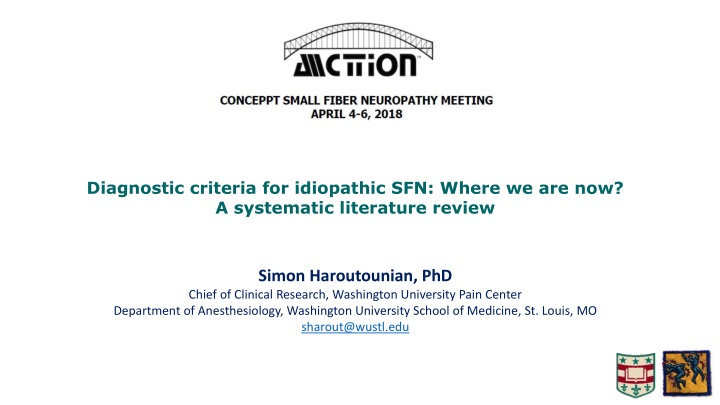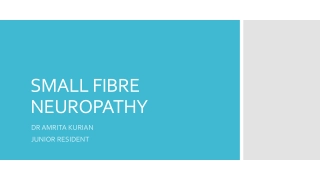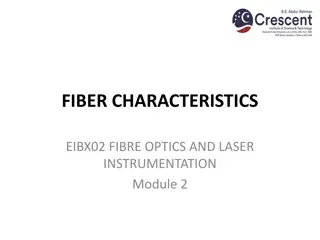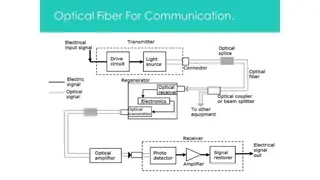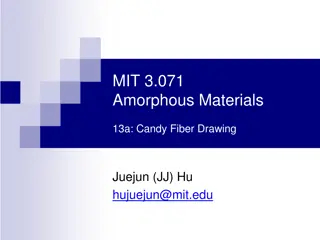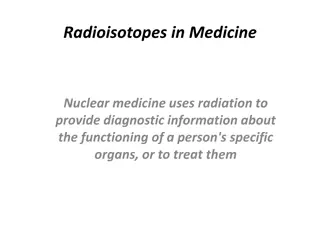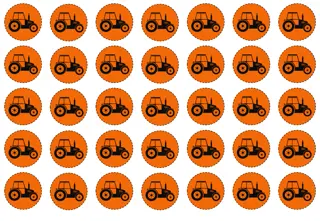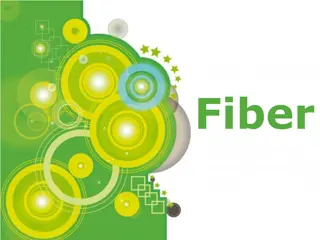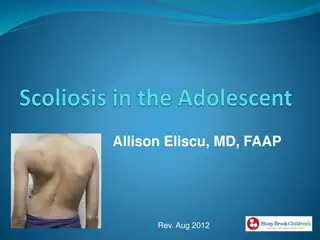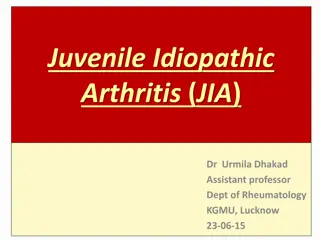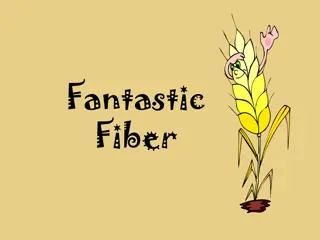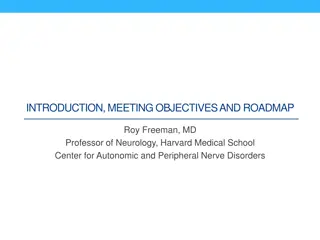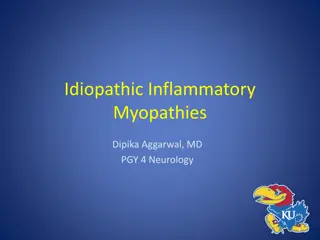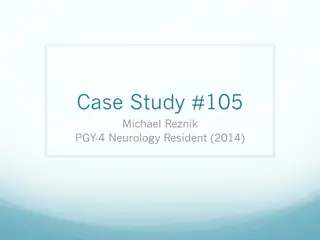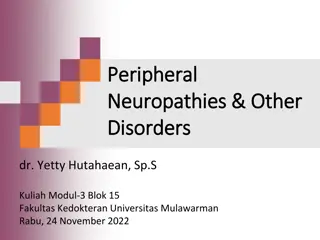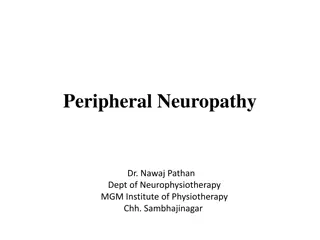Diagnostic Criteria for Idiopathic Small Fiber Neuropathy: Current Status and Future Directions
Small fiber neuropathy (SFN) is a form of peripheral neuropathy characterized by A- and C-fiber abnormalities. While some cases are well-understood, idiopathic SFN remains unclear in about 50% of instances. This study aims to systematically review existing literature on the diagnosis and characterization of idiopathic SFN to provide evidence for revised clinical criteria for this condition.
Download Presentation

Please find below an Image/Link to download the presentation.
The content on the website is provided AS IS for your information and personal use only. It may not be sold, licensed, or shared on other websites without obtaining consent from the author.If you encounter any issues during the download, it is possible that the publisher has removed the file from their server.
You are allowed to download the files provided on this website for personal or commercial use, subject to the condition that they are used lawfully. All files are the property of their respective owners.
The content on the website is provided AS IS for your information and personal use only. It may not be sold, licensed, or shared on other websites without obtaining consent from the author.
E N D
Presentation Transcript
Diagnostic criteria for idiopathic SFN: Where we are now? A systematic literature review Simon Haroutounian, PhD Chief of Clinical Research, Washington University Pain Center Department of Anesthesiology, Washington University School of Medicine, St. Louis, MO sharout@wustl.edu
Small fiber neuropathy (SFN) SFN is a subgroup of peripheral neuropathies mainly characterized by A- and C-fiber abnormalities Patients with SFN usually present with distal symmetric (acral) sensory symptoms, often accompanied by pain Among the commonly reported etiologies of SFN are Diabetes Mellitus (DM) and other metabolic disorders HIV infection Sj gren s syndrome Hypothyroidism Alcoholic neuropathy The etiology of SFN still remains unclear in about 50% of the cases, and they are currently termed idiopathic SFN (iSFN). The diagnostic criteria for and clinical characterization of idiopathic SFN are currently not well-developed. Devigili et al., 2008; eyler et al., 2010, Lauria et al., 2012
Objective Our objective was to: 1. Systematically review and summarize the published literature on the assessment of and diagnostic criteria for idiopathic small fiber neuropathy 2. Provide evidence to support an expert consensus on revised clinical characterization and diagnostic criteria for painful iSFN.
Approach A systematic literature search was performed (July 10, 2017) Keywords: Small fiber neuropathy, SFN, Distal symmetric polyneuropathy, DSP, painful polyneuropathy, idiopathic neuropathy, cryptogenic neuropathy. MeSH terms: Small Fiber Neuropathy Polyneuropathies Diabetic Neuropathies Alcoholic neuropathy Hereditary Sensory and Autonomic Neuropathies Neuropathy, painful Without limiting to types of studies: 43,860 papers
Approach After limiting to: Human studies, Reviews/meta-analyses, and English language studies ("pain"[MeSH Terms] OR "pain"[All Fields]) AND (("Small Fiber Neuropathy"[Mesh] OR ("Polyneuropathies"[Mesh] OR "Alcoholic Neuropathy"[Mesh] OR "Diabetic Neuropathies"[Mesh])) OR "Hereditary Sensory and Autonomic Neuropathies"[Mesh]) OR "Neuropathy, Painful"[Supplementary Concept] AND ((Case Reports[ptyp] OR Clinical Study[ptyp] OR Clinical Trial[ptyp] OR Clinical Trial, Phase I[ptyp] OR Clinical Trial, Phase III[ptyp] OR Clinical Trial, Phase II[ptyp] OR Clinical Trial, Phase IV[ptyp] OR Comparative Study[ptyp] OR Controlled Clinical Trial[ptyp] OR Meta- Analysis[ptyp] OR Multicenter Study[ptyp] OR Observational Study[ptyp] OR Practice Guideline[ptyp] OR Pragmatic Clinical Trial[ptyp] OR Randomized Controlled Trial[ptyp] OR Review[ptyp] OR systematic[sb] OR Validation Studies[ptyp]) AND "humans"[MeSH Terms] AND English[lang]) OR ("small fiber neuropathy"[MeSH Terms] OR ("small"[All Fields] AND "fiber"[All Fields] AND "neuropathy"[All Fields]) OR "small fiber neuropathy"[All Fields]) OR SFN[All Fields] OR (Distal[All Fields] AND symmetric[All Fields] AND ("polyneuropathies"[MeSH Terms] OR "polyneuropathies"[All Fields] OR "polyneuropathy"[All Fields])) OR ("Int Conf Digit Signal Process Proc"[Journal] OR "dsp"[All Fields]) OR (("pain"[MeSH Terms] OR "pain"[All Fields] OR "painful"[All Fields]) AND ("polyneuropathies"[MeSH Terms] OR "polyneuropathies"[All Fields] OR "polyneuropathy"[All Fields])) OR (idiopathic[All Fields] AND neuropathy[All Fields]) OR (cryptogenic[All Fields] AND neuropathy[All Fields]) AND ("humans"[MeSH Terms] AND English[lang]) 6,460 results
Criteria for screening/inclusion Obtain full text, if Clinical study (epidemiological, observational or interventional) OR Review/guidelines AND Patient population includes small fiber neuropathy (or distal polyneuropathy) that is 1. Termed idiopathic or 1. Is of unclear/mixed etiology. Exclude, if Animal study In-vitro / ex-vivo study Clinical studies dealing with polyneuropathy of well-defined etiology i.e. DPN, HIV-SN, CIPN, and other axonal or demyelinating neuropathies.
Approach Each abstract was independently screened by two investigators Mathias Leinders (Washington University) Marta Campagnolo (Harvard) Color coded as follows: EXCLUDE (Irrelevant) MAYBE INCLUDE EXCLUDE INCLUDE (other well-defined etiology)
Records identified through literature search (n=6460) Abstracts independently screened by 2 investigators for inclusion criteria, and color-coded Excluded (n=5867) Disagreements solved by discussion Full text obtained and color-coded for inclusion in data extraction database (n=594) Additional papers identified from references (n=11) REDCap database exclusion criteria: - Non-human study - Clear other etiology (e.g. DPN) - N < 10 subjects (e.g. case-reports) Excluded (n=482) Data extracted and included in analysis iSFN / mSFN (n= 123) Record overview: iSFN (n=11) mSFN (n=74) Reviews/Guidelines (n=38) SFN= small fiber neuropathy iSFN= pure idiopathic SFN mSFN= mixed cases of SFN
Records extracted to REDCap; REDCap extraction details: 1. Characteristics of included record: - Subject demographics, single/multicenter, study arms 2. SFN details/ Study Methodology: - Type/cause SFN, NCS?, SFN defined? SFN Criteria? Pain cut-off? 3. Results: - Symptoms, descriptors, questionnaires - Morphology (biopsy site, details), sensory assessment (site, details), functional assessments (QSART, etc) - Comorbidities, QoL? - Potential risk of bias/ comments - Other patient-centered outcomes Final Records included for analysis (n=123) iSFN: (n=11) mSFN: (n=74) Mixed cased: (n=60) Fabry: (n=4) Hereditary: (n=2) Sarcoidosis: (n=2) Sepsis: (n=1) Amyloidosis: (n=1) Other: (n=4) Data Mapping Direction of change Expected No. difference Reviews: (n=38) Opposite Unclear/mixed SFN diagn. criteria: (n=15) SFN guidelines: (n=3) SFN methods: (n=8) SFN epidem: (n=2) SFN other etiol: (n=4) PSN diagnosis: (n=3) DSP guidelines: (n=3) Abnormal vs. HC Abnormal vs. other
Guidelines and Reviews Guidelines and Reviews - criteria for SFN (n=38) Sensory symptoms in LE (length- dependent) (burning pain, paresthesia, numbness) Abnormal pinprick in length dependent fashion in LE Abnormal quantitative sudomotor axon reflex (QSART) Abnormal thermal perception and/or pain thresholds Abnormal autonomic symptoms Abnormal skin biopsy (reduced IENFD) Laboratory tests (Differential diagnosis) Normal NCS Ewing battery Count 33 16 9 25 15 32 27 5 9 Percentage of total 87% 42% 24% 66% 39% 84% 71% 13% 24% 24% 13% 24% 42% 39% 66% 71% 87% 84% The Ewing battery: 1) HR response to the Valsalva manoeuvre; 2) HR response to standing up; 3) HR response to deep breathing; 4) BP response to standing up; 5) BP response to sustained handgrip. Not included in this summary: Other biopsy findings 7/38 (e.g. swellings); CCM 4/38; CHEPs 1/38; LEPs 3/38, microneurography 4/38
Included studies iSFN, n=11 Idiopathic Skin biopsy Cornea Quantitative sensory testing Nerve conduction studies Add-on tests Cardio vascular testing HR with deep breat hing LDI flare to heat Hista mine skin flare Skin wrinkl ing Proxi- mal Pin- prick Mo- tor Senso ry Q- CHEP s Valsal va Orth. Hypoother Distal other CCM CDT WDT TSL PHS CPT HPT MDT MPS DMA WUR VDT PPT TTT other SSR LEPs SART Dabby, R 2007 Ebadi, H 2012 Faber, CG 2012 Gibbons, CH 2006 Shukla, G 2005 Teoh, HL 2008 Tobin, K 1999 Ueceyler, N 2010 Walk, D 2007 Ebadi, 2015 Holland, 1997 TTT=temperature threshold testing SSR= sympathetic skin response
Included studies iSFN, n=11 Distal Proximal Motor Sensory 27 % 18% 36% 73 % 0 0 0 1 0 0 8 0 0 0 0 0 0 3 2 3 Skin Biopsy Nerve Conduction
Included studies iSFN, n=11 CDT Quantitative sensory testing VDT 73% WDT HPT 55% 45% 2 36% CPT Pinprick 1 PPT TSL 2 0 18% MPS PHS MDT DMA WUR 18% 1 0 0 0 0 9% 9% 9% 9% 9% 9% 9% 2 5 91% 91% 4 4 0 1 1 2 0 0 0 0 0 0 0 0 0 0 0 0 0 0 0 0 1 1 1 1 1 1 1 1 1 0 0 0 0 0 0 0 0 0 0
Included studies iSFN, n=11 Add-on tests LDI-flare SSR 18% 18% HR with deep breathing Ortho. Hypo Valsalva Skin wrinkling CHEPs LEPs Hist. skin QSART 0 0 9% 9% 9% 9% 9% 9% 9% 9% 1 2 0 0 0 0 0 0 0 0 0 0 1 1 1 1 1 1 1 1 1 0 0 0 0 0 0 0 0 0 0 0 0 0 0 0 0 0 Not included in this summary: Other biopsy findings 2/11 (e.g. swellings); CCM 0/11; TTT 1/11
Included studies mSFN, n=74 Nerve conduction studies Mixed Skin biopsy Cornea Quantitative sensory testing Add-on tests Cardio vascular testing Histami ne skin flare Skin wrink. HR with db Valsalvaorth. Distal Proximal other CCM CDT WDT TSL PHS CPT HPT MDT MPS DMA WUR VDT PPT pinprick TTT Motor Sensory other LDI flare SSR QSART CHEPs LEPs other DTR Hypo Atherthon 2007 Axer, 2016 Bakkers, 2014 Bakkers, 2009 Bakkers, 2015 Bednarik, 2009 Bickel, 2002 Boruchow, 2013 Bucher, 2015 Casanova-Molla, 2012 (JPNS) Casanova-Molla, 2011 (JNM) Casanova-Molla, 2012 (Pain) Casanova-Molla, 2011 (Pain) deGreef, 2016 Devigili, 2008 Doppler, 2012 Doppler, 2015 Dori, 2015 Gemignani, 2009 Gemignani, 2010 Gorson, 2008 Herrmann, 2004 Hoitsma, 2011 Holland, 1997 Hsieh, 2015 Karlsson, 2013 JPNS Karlsson, 2013 Khan, 2012 Khoshnoodi, 2016 Koskinen, 2005 Lagerburg, 2015 Lauria, 2011 Lauria, 2015 Lefaucheur, 2015 Liguori, 2011 Lopate, 2013 Low, 2006 Magda, 2002 Martinelli-Boneschi, 2017 Medici, 2013 Nebuchennykh, 2009 Nolano, 2015 Oaklander, 2013 Rousseau, 2016 Saperstein, 2013 Schuller, 2000 Sharma, 2007 Stewart, 1992 Tavakoli, 2012 Tavakoli, 2010 Thaisetthawatkul, 2013 Thaisetthawatkul, 2014 Uceyler, 2013 Uceyler, 2011 Uceyler, 2016 Uluc, 2008 Vas, 2014 . ` Datema, 2012 Killian, 2011 Scherens, 2009 Periquet, 1999 McArthur, 1998 Orstavik, 2006 Zhou, 2011 Brenaut, 2015 Herrmann, 1999 Jamal, 1987 Lang, 2016 Sumner, 2003 Tanislav, 2011 Treister, 2015 Singer, 2004 deSousa, 2006 Samuelsson, 2014
Included studies mSFN, n=74 Sensory Distal 74% Motor 78% Proximal 47% CCM 18 38% 12 0 0 7% 0 2 14 7 46 1 0 0 1 35 20 20 0 0 0 5 Skin Biopsy Nerve Conduction
Included studies mSFN, n=74 Quantitative sensory testing VDT WDT CDT 49% 51% Pinprick QST 45% 55% HPT 47% 53% 36% 64% 32% PHS 68% PPT DMA MDT MPS WUR 17 19 3% 15 TSL 7% CPT 97% 12 4% 7% 4% 4% 93% 11 4% 1 0 1 1 0 1 19% 96% 93% 96% 96% 0 0 96% 0 81% 4 5 1 17 16 16 15 4 1 8 1 0 1 0 0 0 0 0 0 0 0 2 5 0 0 2 0 3 3 3 2 2 2 1 0 0 0 0
Included studies mSFN, n=74 Add-on tests HR with Deep Br 15% Valsalva QSART SSR LDI-flare 85% 11% Ortho. Hypo 11% 9% 7% CHEPs LEPs 89% 89% Hist. skin 91% 8% 93% Skin wrinkling 5% 6 4% 92% 3% 95% 1% 96% 4 97% 5 2 4 0 0 99% 0 0 0 4 0 0 0 1 0 0 0 0 0 0 0 5 4 4 0 0 0 0 0 3 3 3 3 0 0 0 2 2 1 SSR=sympathetic skin response
Therapeutic Clinical Trials in SFN Author, year de Graaf 2016 Ho 2009 Dworkin 2007 Herrmann 2005 Windebank 2004 Weintraub 2004 Sumner 2003 Dyck 2017 Holbech 2015 Raber 2014 Demant 2014 Lohse-Busch 2014 Liu 2014 Maihofner 2013 Jann 2012 Sindrup 2011 Brasch-Andersen 2011 Otto 2008 Holbech 2011 Otto 2007 Schattschneider 2006 Otto 2004 Sindrup 2003 Sindrup 2001 Devers 2000 Sindrup 1999 Low 1995 Journal Trials Pain J Pain (overview of studies) Pain Med JPNS Neurorehabil Neural Repair Neurology (IGT testing) Muscle&Nerve Pain Acta Neurol Belg Pain NeuroRehab Acta Neurol Scand Curr Med Res Opinion Pain Med EJP Eur J Clin Pharm Pain EJP EJP (overview of studies) J Neurol (NE iontophoresis) Neurology Neurology Pain Clin J pain Clin Pharmacol Ther. Pain A separate search for clinical trials: Idiopathic AND painful AND neuropathy (N=19) Cryptogenic AND painful AND neuropathy (N=0) Idiopathic sensory polyneuropathy (N=11) Idiopathic sensory neuropathy (n=15) Painful and Polyneuropathy (N=198) After screening and removing duplicates: N=27
Therapeutic Clinical Trials in SFN SFN criteria for inclusion into trial (n=27) Exclusion of other predisposing factors 10 SFN Pain severity cut-off (avg 4) SFN Relevant Symptoms SFN confirmed by QST SFN confirmed by normal NCS characteri- zation by add- on tests 7 confirmation by skin biopsy Count 24 19 6 9 14 89% 70% 22% 33% 52% 37% 26% Percentage of total 26 % 33 % 37 % 22% 52 % 70% 89%
Summary of findings (1/4) This semi-quantitative presentation of findings suggest Among therapeutic clinical trials in SFN (n=27), inclusion criteria were primarily based on: Neuropathy symptoms in appropriate distribution (89% of studies) Pain severity cut-off (70% studies) SFN confirmed by normal NCS (52% of studies) Exclusion of other predisposing factors (37% of studies) Confirmation by QST (33% of studies) Confirmation by skin biopsy / IENFD (22% of studies)
Summary of findings (1/4) This semi-quantitative presentation of findings suggest Among therapeutic clinical trials in SFN (n=27), inclusion criteria were primarily based on: Neuropathy symptoms in appropriate distribution (89% of studies) Pain severity cut-off (70% studies) SFN confirmed by normal NCS (52% of studies) Exclusion of other predisposing factors (37% of studies) Confirmation by QST (33% of studies) Confirmation by skin biopsy / IENFD (22% of studies)
Summary of findings (2/4) Among guidelines and reviews (n=38), the diagnostic criteria for SFN are primarily based on: Sensory symptoms in appropriate distribution (87%) Abnormal skin biopsy findings / reduced IENFD (84%) Normal NCS (71%) Abnormal thermal perception (66%) Abnormal pinprick - length-dependent (42%) Abnormal QSART (24%) Abnormal autonomic symptoms (39%)
Summary of findings (2/4) Among guidelines and reviews (n=38), the diagnostic criteria for SFN are primarily based on: Sensory symptoms in appropriate distribution (87%) Abnormal skin biopsy findings / reduced IENFD (84%) Normal NCS (71%) Abnormal thermal perception (66%) Abnormal pinprick - length-dependent (42%) Abnormal QSART (24%) Abnormal autonomic symptoms (39%)
Summary of findings (3/4) Among pure iSFN studies (n=11), the findings are: 73% used distal skin biopsies all with results as expected 27% used proximal skin biopsies - all with results as expected 18% used EMG all with results as expected 36% used NCV 3/4 with results as expected 73% tested CDT 5/8 with results as expected 45% tested WDT 4/5 with results as expected 36% tested HPT only in 1/4 the results as expected 55% tested VDT in 4/6 results as expected 18% tested pinprick sensation all mixed/unclear results The rest of QST tests only in a limited number of studies Additional tests (flare/SSR) and autonomic testing only in a limited amount of studies
Summary of findings (3/4) Among pure iSFN studies (n=11), the findings are: 73% used distal skin biopsies all with results as expected 27% used proximal skin biopsies - all with results as expected 18% used EMG all with results as expected 36% used NCV 3/4 with results as expected 73% tested CDT 5/8 with results as expected 45% tested WDT 4/5 with results as expected 36% tested HPT only in 1/4 the results as expected 55% tested VDT in 4/6 results as expected 18% tested pinprick sensation all mixed/unclear results The rest of QST tests only in a limited number of studies Additional tests (flare/SSR) and autonomic testing only in a limited amount of studies
Summary of findings (4/4) Among mixed SFN studies (n=74), the findings are: 78% used distal skin biopsies 46/58 with results as expected 38% used proximal skin biopsies 20/27 with results as expected 7% used CCM all 5 studies with results as expected 47% used EMG 20/35 with results ax expected 74% used NCV 35/55 with results as expected 47% tested CDT in 16/34 the results were as expected 45% tested WDT 17/33 results as expected 32% tested HPT only in 8/24 the results as expected 19% tested CPT no difference vs controls 49% tested VDT in 16/36 results as expected 36% tested pinprick sensation in 15/27 results as expected The rest of QST tests only in a limited number of studies Additional tests (flare/SSR) and autonomic testing only in a limited amount of studies, but CHEPs, LEPs, Histamine flare all results as expected
Summary of findings (4/4) Among mixed SFN studies (n=74), the findings are: 78% used distal skin biopsies 46/58 with results as expected 38% used proximal skin biopsies 20/27 with results as expected 7% used CCM all 5 studies with results as expected 47% used EMG 20/35 with results as expected 74% used NCV 35/55 with results as expected 47% tested CDT in 16/34 the results were as expected 45% tested WDT 17/33 results as expected 32% tested HPT only in 8/24 the results as expected 19% tested CPT no difference vs controls 49% tested VDT in 16/36 results as expected 36% tested pinprick sensation in 15/27 results as expected The rest of QST tests only in a limited number of studies Additional tests (flare/SSR) and autonomic testing only in a limited amount of studies, but CHEPs, LEPs, Histamine flare all results as expected
Acknowledgements Mathias Leinders Marta Campagnolo Bob Dworkin Roy Freeman
